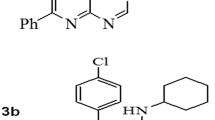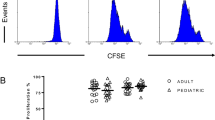Abstract
Decreased immune responses have been documented in hyperbilirubinemic patients. This study investigates the effects of intracellular bilirubin accumulation on lymphoproliferative response to phytohemagglutinin A (PHA). Human peripheral blood mononuclear cells (PBMNC) were preincubated with unconjugated bilirubin dissolved in bovine albumin solution at pathological levels seen in clinical hyperbilirubinemia (0–12 mg/dl), washed, and further cultured with PHA. DNA synthesis was measured by [3H]thymidine uptake. Interleukin-2 (IL-2) activity was determined by the CTLL proliferation assay. The amount of intracellular bilirubin and expression of cell surface antigens were analyzed by flow cytometry.In vitro exposure of normal PBMNC to bilirubin resulted in the accumulation of intracellular bilirubin and a decrease in DNA synthesis after PHA stimulation in a time- and dose-dependent manner. Addition of autologous untreated monocytes could not correct the decreased DNA synthesis of bilirubin-treated lymphocytes. IL-2 production by bilirubin-treated PBMNC after PHA stimulation was significantly decreased compared to bilirubin-untreated PBMNC. However, addition of exogenous IL-2 to pretreated PBMNC could not correct the decreased DNA synthesis. Expression of Tac antigen and transferrin receptor on bilirubin-treated lymphocytes after PHA stimulation was not significantly different from bilirubin-untreated cells. These results suggest that decreased PHA-induced T-lymphocyte proliferation following bilirubin-pretreatment may result from impairment of proliferation at a step beyond transferrin receptor expression. These observations may help explain the increased susceptibility to infection often observed in hyperbilirubinemic patients.
Similar content being viewed by others
References
Pearlman MA, Gartner LM, Lee KS, Eidelman AI, Morecki R, Horoupian DS: The association of kernicterus with bacterial infection in the newborn. Pediatrics 65:26–29, 1980
Armstrong CP, Dixon JM, Taylor TV, Davies GC: Surgical experience of deeply jaundiced patients with bile duct obstruction. Br J Surg 71:234–238, 1984
Holman JM, Rikkers LF, Moody FG: Sepsis in the management of complicated biliary disorders. Am J Surg 138:809–813, 1979
Pitt HA, Cameron JL, Postier RG, Gadacz TR: Factors affecting mortality in biliary tract surgery. Am J Surg 141:66–72, 1981
Ansaldi N, Fiandino G, Ciriotti G: Changes of the immunoglobulin level in hyperbilirubinemic premature infants. Minerva Pediatr 20:1982–1984, 1968
Nejedla Z: The development of immunological factors in infants with hyperbilirubinemia. Pediatrics 45:102–104, 1970
Diaz del Castillo E: Neonatal hyperbilirubinemia. Its relation to the immunological response capacity of the newborn infant. Gac Med Mex 105:185–207, 1973
Newble DI, Holmes KT, Wangel AG, Forbes IJ: Immune reactions in acute viral hepatitis. Clin Exp Immunol 20:17–28, 1974
Newberry WM, Shorey JW, Sanford JP, Combes B: Depression of lymphocyte reactivity to phytohemagglutinin by serum from patients with liver disease. Cell Immunol 6:87–97, 1973
Haga Y, Sakamoto K, Egami H, Yokoyama Y, Arai M, Mori K, Akagi M: Changes in production of interleukin 1 and interleukin 2 associated with obstructive jaundice and biliary drainage in patients with gastrointestinal cancer. Surgery 106:842–848, 1989
Roughneen PT, Gouma DJ, Kulkarni AD, Fanslow WF, Rowlands BJ: Impaired specific cell mediated immunity in experimental biliary obstruction and its reversibility by internal biliary drainage. J Surg Res 41:113–125, 1986
Megison SM, Dunn CW, Horton JW, Chao H: Immunologic recovery after biliary drainage in obstructive jaundice. Curr Surg 5:383–385, 1989
Thompson RLE, Diamond MHT, Rowlands BJ: Development and reversibility of T lymphocyte dysfunction in experimental obstructive jaundice. Br J Surg 77:1229–1232, 1990
Megison SM, Dunn CW, Horton JW, Chao H: Effects of relief of biliary obstruction on mononuclear phagocyte system function and cell mediated immunity. Br J Surg 78:568–571, 1991
Nie CH, Grogan JB, Crick MP, Connor CE: Impaired response to alloantigens in murine biliary obstruction. J Surg Res 54:145–149, 1993
Desmet VJ: Morphologic and histochemical aspects of cholestasis.In Progress in Liver Diseases, Vol. IV. H Popper, F. Schaffner (eds). New York, Grune & Stratton, 1972, pp 97–132
Rola-Pleszczynski M, Hensen SA, Vincent MM, Bellanti JA: Inhibitory effect of bilirubin on cellular immune responses in man. J Pediatr 86:690–696, 1975
Thong YH, Ness D, Ferrante A: Effect of bilirubin on the fungicidal capacity of human neutrophils. Sabouraudia 17:125–129, 1979
Sima P, Mala J, Miler I, Hodr R, Truxova E: The suppressive effect of continuous infusion of bilirubin on the immune response in mice. Folia Microbiol 25:483–490, 1980
Miler I, Vondracek J, Hromadkova L: Bilirubin inhibits the chemotactic activity of human polymorphonuclear leukocytesin vitro. Folia Microbiol 26:413–416, 1981
Svejcar J, Miler I, Pekarek J: Effect of bilirubin on anin vitro correlate of cell mediated immunity—the migration inhibition test. J Clin Lab Immunol 13:145–149, 1984
Miler I, Vetvicka V, Sima P, Hodr R, Truxova E: The effect of bilirubin on the phagocytic activity of mouse peripheral granulocytes and monocytesin vivo. Folia Microbiol 30:267–271, 1985
Vetvicka V, Miler I, Sima P, Taborsky L, Fornusek L: The effect of bilirubin on the Fc receptor expression and phagocytic activity of peritoneal macrophages. Folia Microbiol 30:373–380, 1985
Nakamura H, Uetani Y, Komura M, Takada S, Sano K, Matsuo T: Inhibitory action of bilirubin on superoxide production by polymorphonuclear leukocytes. Biol Neonate 52:273–278, 1987
Feduccia TD, Scott-Conner CEH, Grogan JB: Profound suppression of lymphocyte function in early biliary obstruction. Am J Med Sci 296:39–44, 1988
Gianni L, Di Padova F, Zuin M: Bile acid-induced inhibition of the lymphoproliferative response to phytohemagglutinin and pokeweed mitogen: Anin vitro study. Gastroenterology 78:231–235, 1980
Greve JW, Gouma DW, Soeters PB: Suppression of cellular immunity in obstructive jaundice is caused by endotoxins: A study with germ-free rats. Gastroenterology 98:478–485, 1990
Neckers LM, Cossman J: Transferrin receptor induction in mitogen-stimulated human T lymphocytes is required for DNA synthesis and cell division and regulated by interleukin-2. Proc Natl Acad Sci USA 80:3494–3498, 1983
Smith KA, Cantrell DA: Interleukin-2 regulates its own receptors. Proc Natl Acad Sci USA 82:864–868, 1985
Gutgsell NS, Malek TR: Formation of high affinity IL-2 receptors is dependent on a nonligand binding region of theα subunit. J Immunol 153:3899–3907, 1994
Tanaka T, Saiki O, Doi S, Negoro S, Kishimoto S: Interleukin 2 functions through novel interleukin 2 binding molecules in T cells. J Immunol 140:470–473, 1988
Kumagai N, Benedict SH, Mills GB, Gelfand EW: Comparison of phorbol ester/calcium ionophore and phytohemagglutinin-induced signaling in human T lymphocytes. J Immunol 140:37–43, 1988
Haga Y, Kay HD, Tempero MA, Zetterman RK: Flow cytometric measurement of intracellular bilirubin in human peripheral blood mononuclear cells exposed to unconjugated bilirubin. Clin Biochem 25:277–283, 1992
Haga Y, Tempero MA, Kay HD, Zetterman RK: Characterization of bilirubin transport system by human peripheral blood mononuclear cells. J Leukocyte Biol 51:2–6, 1992
Kay HD, Petrie HT, Burge JJ, Klassen LW: Rapid recovery of non-hemolyzed serum and untraumatized cells by using a new method of blood defibrinationin vitro. J Immunol Methods 92:251–260, 1986
Kumagai K, Itoh K, Hinuma S: Pretreatment of plastic petri dishes with fetal calf serum. A simple method for macrophage isolation. J Immunol Methods 29:17–25, 1979
Lee KC, Shiozawa C, Shaw A, Diener E: Requirement of accessory cells in the antibody response to T cell-independent antigensin vitro. Eur J Immunol 6:63–68, 1976
Gillis S, Ferm MM, Ou W, Smith KA: T cell growth factor: Parameters of production and a quantitative microassay for activity. J Immunol 120:2027–2032, 1978
Le Bouteiller PP, Mishal Z, Lemonnier FA, Kourilsky FM: Quantification by flow cytofluorimetry of HLA class I molecules at the surface of murine cells transformed by cloned HLA genes. J Immunol Methods 61:301–315, 1983
Brodersen R: Aqueous solubility, albumin binding, and tissue distribution of bilirubin.In Bile Pigments and Jaundice. JE Ostrow (ed). New York, Marcel Dekker, 1986, pp 157–181
Suzuki N, Yamaguchi T, Nakajima H: Role of high-density lipoprotein in transport of circulating bilirubin in rats. J Biol Chem 263:5037–5043, 1988
Forni G, Giovarelli M, Santoni A, Modesti A, Forni M: Interleukin 2 activated tumor inhibitionin vivo depends on the systemic involvement of host immunoreactivity. J Immunol 138:4033–4041, 1987
Author information
Authors and Affiliations
Rights and permissions
About this article
Cite this article
Haga, Y., Tempero, M.A., Kay, D. et al. Intracellular accumulation of unconjugated bilirubin inhibits phytohemagglutinin-induced proliferation and interleukin-2 production of human lymphocytes. Digest Dis Sci 41, 1468–1474 (1996). https://doi.org/10.1007/BF02088574
Received:
Revised:
Accepted:
Issue Date:
DOI: https://doi.org/10.1007/BF02088574




